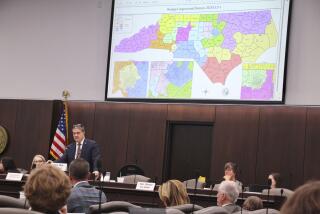Census Technique Target of Lawsuit
- Share via
WASHINGTON — The standoff over how to count the nation’s population spilled into the courts Thursday as a public interest group filed a lawsuit aimed at blocking the Clinton administration from using a controversial counting method in the 2000 census.
California has a significant interest in the outcome of the debate about the technique, which also remains unresolved in Congress.
The Southeastern Legal Foundation of Atlanta, a conservative public interest law firm, challenged the administration’s plan to use statistical sampling to estimate the portion of the population that is hardest to count. The group termed the sampling method a threat to the U.S. form of representative government.
“The integrity of the census count is every bit as crucial . . . as the integrity of the ballot box. We don’t guess at the number of votes in our elections and we should not guess at the number of people in America,” foundation President Matthew J. Glavin said after the lawsuit was filed in federal district court.
The method’s proponents, who include demographic experts, say sampling would prevent another undercount like the one that plagued the 1990 census. That time, officials say, 1.6% of the nation’s population was missed--including 1 million people in California, which cost the state $500 million in lost federal funds and one congressional seat.
So great are the stakes that the city of Los Angeles is considering filing a brief that would support the defense of sampling that federal officials will make on behalf of the Clinton administration. With a sizable population of poor people, minorities and immigrants--the residents most often missed by the traditional door-to-door head count--Los Angeles is in danger of losing federal funds apportioned on the basis of population.
“The city will look very seriously at any attempt to stop sampling in 2000 and make a decision about what action it might take,” said Assistant City Atty. Jessica Heinz. “We have a cure for the undercount; let’s use it.”
A test of sampling is scheduled for April in Sacramento.
The lawsuit was not unexpected, given the battle over sampling that erupted in Congress last year. The spending bill that funds the Census Bureau was passed with a provision for speedy judicial review of whether statistical projection is constitutional; the lawsuit starts that process.
Most congressional Republicans oppose sampling on the grounds that it is a violation of the Constitution’s mandate that every person in the nation be counted. Privately, though, party leaders worry that sampling will increase the count of urban poor and minorities, who traditionally vote Democratic, and thus threaten GOP control of the House when population figures are used to apportion congressional districts.
Demographers say the nation’s vast population and the number of hard-to-reach residents make a traditional head count implausible. Under the proposed method, every effort would be made to count every resident, including techniques never before tried, such as making census forms available in public places. Those who are still not counted would be estimated by statistical projection and those results would be checked for accuracy, a plan experts believe would dramatically reduce the undercount.
“The administration is committed to conducting the most accurate census possible, using the best, most up-to-date scientific methods,” said Andrew Pincus, general counsel for the Department of Commerce, which oversees the Census Bureau.
The Supreme Court has not ruled on the merits of sampling, but the method has been upheld by several lower courts.
More to Read
Sign up for Essential California
The most important California stories and recommendations in your inbox every morning.
You may occasionally receive promotional content from the Los Angeles Times.












